
The history of Stockholm, capital of Sweden, for many centuries coincided with the development of what is today known as Gamla stan, the Stockholm Old Town. Stockholm's raison d'être always was to be the Swedish capital and by far the largest city in the country.

Gamla stan, until 1980 officially Staden mellan broarna, is the old town of Stockholm, Sweden. Gamla stan consists primarily of the island Stadsholmen. Officially, but not colloquially, Gamla stan includes the surrounding islets Riddarholmen, Helgeandsholmen and Strömsborg. It has a population of approximately 3,000.

Stockholm Palace or the Royal Palace is the official residence and major royal palace of the Swedish monarch. Stockholm Palace is in Stadsholmen, in Gamla stan in the capital, Stockholm. It neighbours the Riksdag building. The offices of the King, the other members of the Swedish royal family, and the Royal Court of Sweden are here. The palace is used for representative purposes by the King whilst performing his duties as the head of state.

The City of Stockholm is situated on fourteen islands and on the banks to the archipelago where Lake Mälaren meets the Baltic Sea. The city centre is virtually situated on the water.

The Swedish East India Company was founded in Gothenburg, Sweden, in 1731 for the purpose of conducting trade with China and the Far East. The venture was inspired by the success of the Dutch East India Company and the British East India Company. This made Gothenburg a European centre of trade in eastern products. The main goods were silk, tea, furniture, porcelain, precious stones and other distinctive luxury items. Trade with China saw the arrival of some new customs in Sweden. The Chinese cultural influence increased, and tea, rice, arrack and new root vegetables started appearing in Swedish homes.

Karlskrona is a locality and the seat of Karlskrona Municipality, Blekinge County, Sweden with a population of 66,675 in 2018. It is also the capital of Blekinge County. Karlskrona is known as Sweden's only baroque city and is host to Sweden's largest naval base and the headquarters of the Swedish Coast Guard.

Count Nicodemus Tessin the Younger was a Swedish Baroque architect, city planner, and administrator.

Storkyrkan, also called Stockholms domkyrka and Sankt Nikolai kyrka, is the oldest church in Stockholm. Storkyrkan lies in the centre of Stockholm in Gamla stan, between Stockholm Palace and Stortorget, the old main square of Stockholm. It was consecrated to Saint Nicholas in 1306 but construction of the church probably started in the 13th century. Inside, Storkyrkan still maintains much of its late medieval appearance in the form of a hall church with a vaulted ceiling supported by brick pillars. The exterior of the church is however uniformly Baroque in appearance, the result of extensive changes made in the 18th century. The church played an important role during the Reformation in Sweden as the place where Mass was celebrated in Swedish for the first time. It currently serves as the seat of the Bishop of Stockholm within the Church of Sweden since the creation of the Diocese of Stockholm in 1942.
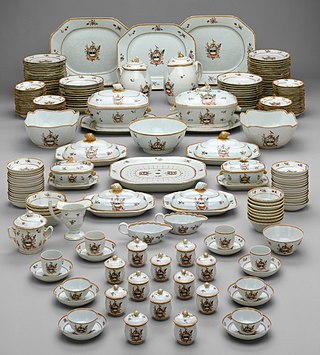
Chinese export porcelain includes a wide range of Chinese porcelain that was made (almost) exclusively for export to Europe and later to North America between the 16th and the 20th century. Whether wares made for non-Western markets are covered by the term depends on context. Chinese ceramics made mainly for export go back to the Tang dynasty if not earlier, though initially they may not be regarded as porcelain.

Strandvägen is a street on Östermalm in central Stockholm, Sweden. Completed just in time for the Stockholm World's Fair 1897, it quickly became known as one of the most prestigious addresses in town.
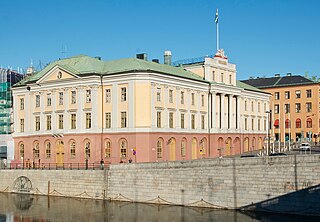
Arvfurstens palats is a palace located at Gustav Adolfs Torg in central Stockholm.

Erik Palmstedt was a Swedish architect working for the court circle of Gustav III, where he was in the forefront of Neoclassical style and at the heart of a social and intellectual circle that formed round him. He was also a musician, who served as organist at Riddarholm Church for twenty-seven years.
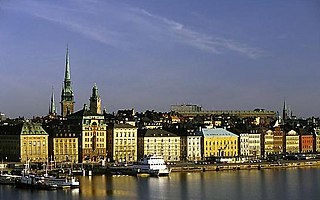
Skeppsbron is both a street and a quay in Gamla stan, the old town of Stockholm, capital of Sweden, stretching from the bridge Strömbron in front of the Royal Palace southward to Slussen.

Södra Bankohuset or Gamla Riksbanken is a building in Gamla stan, the old town of Stockholm, Sweden, together with Norra Bankohuset the location of the Bank of Sweden until 1906. Since December 2018, the building is housing Embark Studios, a Stockholm-based games studio.

Karl Johanslussen is a lock and a sluice, along the Söderström river connecting and controlling the flood discharge between Riddarfjärden, the easternmost part of Lake Mälaren, and Saltsjön, the section of the Baltic Sea reaching into central Stockholm, Sweden. The lock is 75 metres long, 10 metres wide and 3.90 metres deep. The maximum height is 3.8 metres. The lock is closed from 2016 to 2021 due to large reconstruction works in the area.
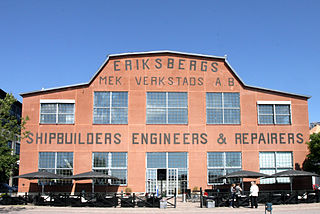
Eriksbergs Mekaniska Verkstads AB was a Swedish shipbuilding company based in Gothenburg. It was founded in 1850 by Christian Barchman under the name Ericsbergs metall och tackjerns-gjuteri. It delivered its last ship in 1979.

Stockholm during the early Vasa era (1523–1611) is a period in the history of Stockholm when Gustav Vasa and his sons, Eric, John, John's son Sigismund, and finally Gustav's youngest son Charles, ruled Sweden from the Stockholm Palace.
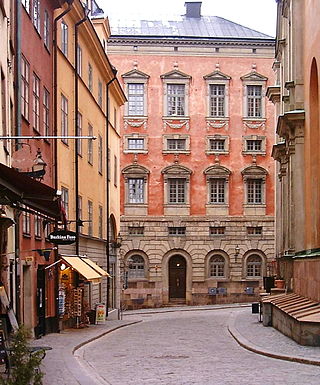
Stockholm during the Swedish Empire (1611–1718) is the period in the history of Stockholm when the city grew sixfold, many of its present streets were created, and its economy boomed.
Stockholm during the Middle Ages is the period in the history of Stockholm stretching from the foundation of the city c. 1250 to the end of the Kalmar Union in 1523. During this period, Stockholm still didn't fill up the small island Stadsholmen which today known as the Stockholm Old Town, and as a consequence this article to some extent overlaps that of Gamla stan.

Åbo Skeppswarfs Aktie Bolaget was a shipbuilding company that operated in Turku, Finland Proper, in 1741–1883.























